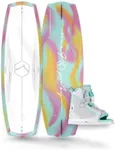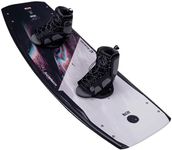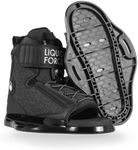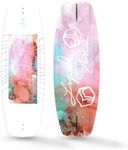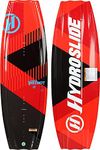Buying Guide for the Best Kids Wakeboards
Choosing the right wakeboard for your child can make a huge difference in their enjoyment and progression in the sport. It's important to consider several key specifications to ensure the wakeboard matches their skill level, weight, and riding style. Here are the main factors to consider when selecting a kids' wakeboard and how to navigate through them to find the best fit for your child.SizeThe size of the wakeboard is crucial because it affects the stability and maneuverability of the board. Wakeboards are measured in centimeters, and the right size depends on the rider's weight. Generally, shorter boards are easier to maneuver and are better for tricks, while longer boards provide more stability and are better for beginners. To choose the right size, refer to the manufacturer's size chart, which matches the rider's weight to the appropriate board length.
Rocker TypeThe rocker refers to the curvature of the wakeboard from tip to tail. There are three main types: continuous, 3-stage, and hybrid. Continuous rockers have a smooth curve and provide a predictable ride, making them great for beginners. 3-stage rockers have distinct flat spots, offering more pop off the wake but can be less smooth on the water. Hybrid rockers combine elements of both. Choose a continuous rocker for beginners or those who prefer a smooth ride, and a 3-stage or hybrid for more advanced riders looking for higher jumps.
BindingsBindings are the boots that attach your child's feet to the wakeboard. They are important for comfort and control. Bindings come in open-toe and closed-toe designs. Open-toe bindings are more adjustable and can fit a range of foot sizes, making them ideal for growing kids or sharing among siblings. Closed-toe bindings offer a more secure fit and better performance but are less adjustable. Choose open-toe bindings for versatility and growing feet, and closed-toe for a more customized fit and advanced performance.
FinsFins are located on the bottom of the wakeboard and help with stability and tracking. Larger fins provide more stability and are better for beginners, while smaller fins allow for more maneuverability and are preferred by advanced riders. Some wakeboards have removable fins, allowing you to customize the ride. For beginners, choose a board with larger, fixed fins for stability. As your child progresses, you can consider boards with smaller or removable fins for more advanced tricks.
WeightThe weight of the wakeboard affects how it handles on the water. Lighter boards are easier to maneuver and are better for tricks, while heavier boards provide more stability and are better for beginners. The weight of the board should be appropriate for the rider's size and strength. Choose a lighter board for smaller, more agile riders who want to perform tricks, and a heavier board for larger riders or those who need more stability.
Skill LevelWakeboards are designed with different skill levels in mind: beginner, intermediate, and advanced. Beginner boards are more stable and forgiving, making it easier to learn the basics. Intermediate boards offer a balance of stability and performance, while advanced boards are designed for high performance and tricks. Choose a board that matches your child's current skill level to ensure they have the best experience and can progress safely.

